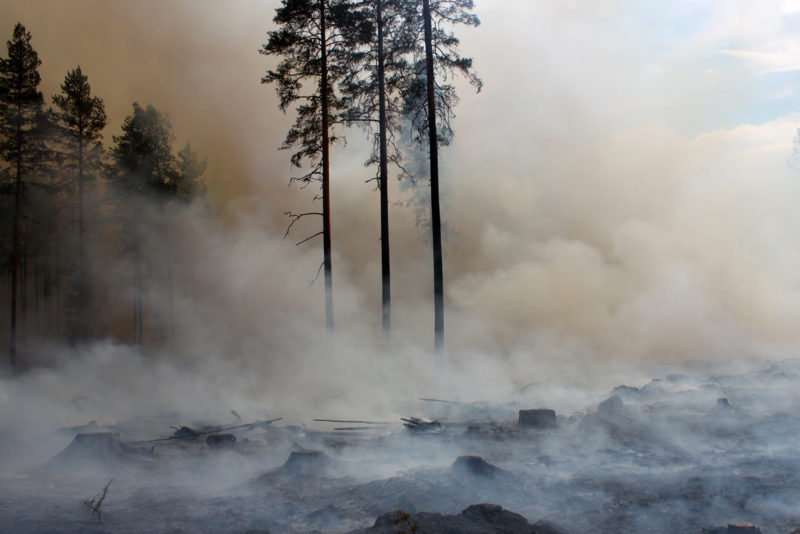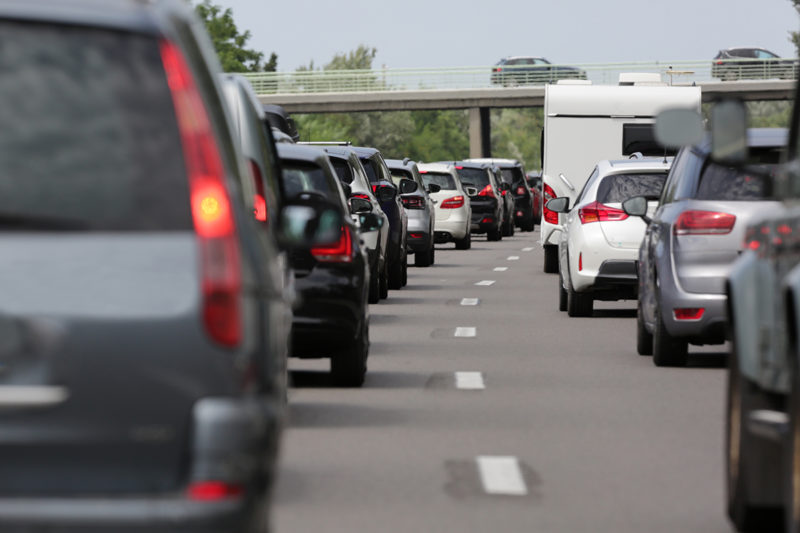Markets for voluntary emissions reductions are growing – plans for common regulation started long ago, but negotiations are still on-going

The carbon market requires both international and national regulation, because the link between payments and genuine climate benefits is often weak. At present, every European carbon sink acquired as carbon offset is included in offset calculations at least twice.
In Washington and Oregon, USA, the forests reserved for carbon offsets for Microsoft and British Petroleum suffered a wildfire last summer, as reported by the Financial Times in early August. The article says the fire was extensive enough to threaten the entire carbon compensation system.
BP, for example, has bought carbon offsets in the Colville Indian Reservation in Washington for USD 100 million. The company is also the major shareholder in a carbon offset developer. At least some of BP’s compensation forests have burned down.
The news is a grim example of the uncertainty linked to mitigating climate change by means of carbon offsets.
’They have been widely used in the USA as extensive compensation for emission reductions, and subsequently a significant share of the forests reserved as offsets have burned down,’ says Tatu Torniainen, Ministerial Adviser at the Finnish Ministry of Agriculture and Forestry.
Torniainen points out that problems related to the permanence of forest carbon storages are not unknown in Finland, either.
’Forest fires have not been a big problem here, but we may face damage caused by storms, insects or fungi, which threaten forest carbon sinks,’ says Torniainen.

Activity in Europe remains small-scale
Carbon offset refers to the activity of a greenhouse gas emitter to combat climate change by creating carbon sinks. Companies often see this as an alternative to reducing emissions.
There are many types of actors on the carbon offset market. The most recent of these are marketplaces, such as Finite Carbon, which was acquired by BP. Their purpose is to bring together those offering sinks and those willing to pay for them.
In addition to the variety of actors there is an absence of generally agreed rules in the carbon offset market. Rules are being intensively debated, however, and the principles are beginning to take shape.
There are many types of actors on the carbon offset market and no generally agreed rules exist.
As of now, carbon offsets mainly rely on nature-based solutions, such as carbon sinks in agriculture and forestry. There are other types, too: in September it was announced that LapWall, a producer of wooden construction elements was approved as a provider of carbon sequestering in the Puro.earth marketplace that brokers carbon offsets.
In Europe, at least, the carbon offset business is still small-scale, but it may see a sharp growth, possibly leading to a significant impact on national economies.
Many big companies would like to buy carbon sinks, but are unable to find reliable provision.

Company reputation acts as driver
For Finland with its extensive forests there is a risk that the European automotive industry, for example, becomes interested in carbon sinks and offers forest owners sums large enough for them to lose interest in forestry. This could lead to a rapid and extensive removal of forests from commercial use and, in consequence, a weakening of the contribution to national economy from wood processing.
’That is a possibility,’ admits Torniainen, but stresses that carbon offset activity is of no use to companies unless it is a good one, and the criteria for this are precisely what authorities are currently working on.
The primary advantage to companies from carbon offsets is a move to low-carbon activity, which is also good for reputation management. Carbon offsets can be highlighted in corporate communication, but for this very reason the advantage to both the climate and the purchaser should be openly verifiable.
Another important factor is that third parties should not be harmed by offsets.
Reductions should come before offsets
The Bio Rex café in Helsinki. The first real information event since the spring of 2020.
What is on offer is information about a private carbon register, reported to be the first Finnish carbon offset system with a partial ISO certification. ISO certification is the nationally and internationally most widely known and officially approved certification system.
The register allows anyone to offset their annual carbon emissions. Companies, for example, can offset the emissions from manufacturing any of their products.
But, as pointed out by Kimmo Piippo, CEO of Rakeistus, the company in charge of the register, the aim is only to offset emissions that cannot be eliminated using other measures. A good carbon offset is always a last-resort option.
’In the first instance, a carbon emission is to be avoided, because then no offset is required. If it cannot be avoided, it should be reduced. Only the part that cannot be avoided should be offset by arranging a sink,’ says Torniainen.
Storage must be additional and permanent
Rakeistus creates carbon sinks by using ash fertilization. This naturally improves forest growth, but it also needs to be genuinely additional. In other words, fertilization would not take place without the offset project.
Fertilization is financially the most profitable method of forest improvement. Where is the guarantee that it would not be done without the offset project?
Provided the area for ash fertilization is selected appropriately, timber growth will increase by 20 to 50 percent. However, the storage created by means of the sink should also be permanent.
Torniainen says that the normal criterion for storage permanence in international projects is a minimum life of a hundred years. Rakeistus only promises a life of 15 to 20 years. After that, the forest owner is free to harvest the site.
A buffer is also needed
Permanence is also affected by natural disasters. Carbon offset projects take these into account by installing buffers; that is, accepting only a part of the actual sink as offset. The smaller the part accepted, the greater the buffer, and the smaller the risk of the storage being completely destroyed.
With Rakeistus, the over-compensation buffer is fairly low: the storage approved as offset is 80 percent of the full size. This can be compared to the Compensate Foundation, which brokers carbon offsets and uses over-compensation of up to almost four times the amount of the sink.
’The main reason for using over-compensation is that the current quality standards are not sufficient,’ says Niklas Kaskeala, Chief Impact Officer at Compensate Foundation.
’Another reason is that we want to take into account the historical carbon debt and to compensate for that as well. On top of that, we take into account effects on biodiversity and social relationships,’ says Kaskeala.
Certification acts as safeguard
Offset sinks brokered by Rakeistus are first assessed using forest growth models. At later stages the sink development is monitored by measurements.
’We visit the forests used as offsets every five years. We measure the forest growth and compare it with a corresponding unfertilized forest, which is something we must always have at hand. The difference will then show us the size of the sink created with fertilization,’ says Timo Soininen from Kiwa, a company which audits ISO certifications.
Certification is also a means of ensuring that the carbon sinks in any offset forest will only be sold once.
Auditing by a third party, such as is used by Rakeistus, is an expensive method. Torniainen notes that the price of verification is clearly a problem.
’Companies have proposed that authorities should assume this task, but I don’t think this is possible at the present stage. If it’s expensive for someone, it’ll also be expensive for us, and using taxpayers’ money would need to be justified really well,’ Torniainen says.
Afforestation is a possibility
Carbon offset projects related to agriculture and forestry come in many shapes, all with their own particular problems. Torniainen is most hopeful about agricultural projects designed to sequester carbon in the soil.
In forestry, afforestation of treeless areas is fairly certainly an additional operation, especially in countries with no public subsidies for afforestation.
In global terms, afforestation has great potential. According to the Worldwatch Institute, the world’s forest area has decreased due to human activity from six thousand million hectares to four thousand million, and the two thousand million lost could be restored, according to Worldwatch, though not necessarily just where they were lost.
Afforestation of treeless areas is fairly certainly an additional operation.
Carbon emissions are also offset by postponing the regeneration felling of a forest by, say, 20 years. The growth increment due to this can also be calculated. However, the permanence of this storage is nowhere near a hundred years.
’Also, how should we view using that postponement to offset emissions in the here and now, with a storage that will only be created in the distant future,’ asks Torniainen.
Forest conservation may lead to carbon leakage
A method used in California, for example, is forest conservation. This, however, causes no immediate change in the forest, and any increase in growth will only be seen in the very long run, if at all.
’Of course, you can say that conservation saved the forest from being felled. This may be the case, but how would you verify it?’ asks Torniainen.
Conservation may also lead to carbon leakage, caused by the global demand for forest products.
’Many people in Finland think that as long as we reduce fellings here, the climate will be saved. But if demand continues on the same level, the fellings will only move to the neighbour’s or the neighbouring country’s forests, with no benefit at all to the climate,’ Torniainen says.
Carbon leakage has actually been proved by research. In practice, it may be concluded that in terms of climate impact, carbon leakage may turn conservation into national greenwashing: it may improve the domestic carbon balance while doing nothing for the climate.
Torniainen points out that carbon offset systems should not harm third parties. Resorting to conservation would create problems if industry then had difficulty in procuring timber.
If global demand continues on the same level, setting forest areas aside will only move the loggings to the neighbour’s or the neighbouring country’s forests, with no benefit at all to the climate.
As a rule of thumb, each tree felled generates tenfold the national product in industry compared to what it generates in forestry. With conservation, that extra would remain unrealised for every tree, even if the forest owner does receive a compensation.
’The Finnish climate panel, for one, has stressed the low cost of forest conservation in comparison to emission reductions. That is a possible conclusion if the impact of conservation on national economy is overlooked,’ says Torniainen.
Duplicate calculation remains an unsolved problem
A problem so far unresolved is duplicate calculation. This means that every single carbon sink is automatically included in the national carbon balance sheet. If it is also calculated as the carbon offset of an individual company, it will be calculated twice.
There have been many responses to this problem. Some pretend it does not exist. Others, such as the Finnish printing house PunaMusta, have opted to stay completely outside domestic carbon offset systems until the duplicate calculation problem is solved.
PunaMusta’s offset is located in Peru, in an area of rainforest which, according to the company, was threatened by destruction and is now conserved. The company’s quality and sustainability manager Jari Martovaara says that the size of the offset is determined by comparing growth on the conservation site with a comparison site, which has been defined on the basis of the international Verified Carbon Standard and Gold Standard.
There have been many responses to duplicate calculation. Some pretend as if there were not a problem at all.
The Compensate Foundation has solved the problem by acquiring all its carbon offsets in countries where duplicate calculation can be avoided.
A hectic debate in social media claims duplicate calculation to mean that the government has more or less nationalised the carbon sinks in forest owners’ forests. In Ireland, forest owners and the government are in open conflict about who really owns the carbon sinks.
’The principle of reporting carbon sinks on the national carbon balance sheet is based on several international climate agreements. This is because at the beginning, agreement on climate issues was negotiated between governments. At the moment we don’t really have a viable alternative to this in the international system,’ Torniainen says.
Duplicate calculation does not constrain offsets, but communicating about them
Compensate Foundation’s Kaskeala points out that duplicate calculation actually prevents companies from using domestic emission offsets.
Surely it does not prevent offsets; isn’t it more correct to say that it places constraints on how companies can speak of offsets in their communication?
’It prevents credible claims about offsets. And it’s precisely those claims that are the main driver of voluntary carbon offsets,’ Kaskeala replies.
Torniainen considers that the duplicate calculation problem can be solved, but this requires a political decision about setting an official register of private offsets. Registered offsets could then be subtracted from the national carbon balance.
Such a register has been proposed by the Finnish Ministry of the Environment, among others. As far as is known, a register of this type does not exist in any European country.
Article 6 of the Paris Climate Agreement is designed to contain a more detailed exposition on these registers, but the text has not been finalised.
’As soon as that has been achieved, the European Union will probably use it to draft a guideline, and national measures can then be expected,’ says Torniainen.
Governments look for reciprocal solutions
Kaskeala considers it a waste of time to wait for international decisions.
’We’ve been waiting for that for four years now. Even without it, Finland could set up the register this very day,’ says Kaskeala.
But if we do so, isn’t there a risk that the register is not compatible with the later guidelines from the EU?
’I don’t think so. In practice, the register is a very simple instrument. I would sooner think that the EU can base its own guideline on Finland’s experience, and Finland could be in the vanguard here,’ Kaskeala says.
At the same time, certain countries have started making reciprocal arrangements for trading carbon offsets. ’The Nordic countries are already piloting a carbon market cooperation compatible with the Paris Agreement,’ says Senior Consultant Hanna-Mari Ahonen from the research and consulting company Perspectives Climate Group.
Switzerland has concluded agreements with Peru, Ghana and Senegal, and is negotiating with some other countries. ’Japan, too, has for over ten years carried on carbon market cooperation within the Joint Crediting Mechanism with almost 20 developing countries. They strive to update the system to comply with the Paris Agreement as regards duplicate calculation, among other things,’ says Ahonen.
Costa Rica recently concluded an agreement with the Gold Standard certification system active in the market, to safeguard the quality of voluntary carbon trading.
Carbon offsets may revolutionize all climate policy
So far, European carbon offset projects have been modest – but the situation may change.
’For all we know, the front line of future climate policy may later be occupied by businesses or, say, cities. And if this happens, the whole system will have to be reconfigured,’ says Torniainen.
If a significant share of carbon sinks was to move from governments to a register of private offsets, Torniainen considers that governments would have to reassess their carbon sink targets.
’Private money would probably find its way to the most economical projects, and costlier ones would have to be undertaken by governments. The price tag of climate policy might go up considerably, unless its targets were also reassessed,’ says Torniainen.
Kaskeala does not view this as a problem.
’If we want to make progress with climate issues, there are certain things we have to do and pay for, regardless of whether the money comes from private offsets or tax revenue.’
’Offsets as such are only a temporary measure. They don’t reduce emissions, but they may steer actors to more effective action. Ultimately, the goal is to make them redundant,’t says Kaskeala.